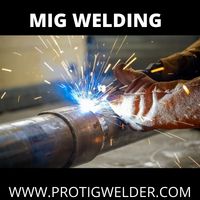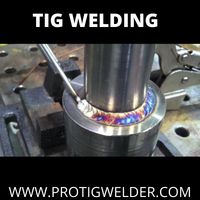Mig and Tig welding are two of the most popular types of welding. They use different methods and produce different results. Mig welding uses a wire electrode that is continuously fed through the gun while tig welding uses a non-consumable tungsten electrode to create the weld. Both methods have their own benefits and drawbacks, so it’s important to understand What is mig and tig welding and what is the differences before deciding which one is right for you.
What is MIG and TIG Welding
So now that we’ve covered the basics, let’s take a look at what is mig and tig welding to determine which one may be right for you.
MIG Welding

Mig welding has many advantages:
-it’s very fast (typically 35 inches per minute or faster)
-it forms nice, flat beads on sheet metal
-the bead height is consistent
-it’s easy to learn
-it’s self-shielding, so the arc won’t contaminate other parts of the weld
Mig welding has a few disadvantages:
-it can be difficult to strike an arc at the root of thick metals
-it requires slightly more energy than most other welding processes
-it cannot be used on AC power currents because the inverter creates too much heat
Tig Welding

Tig welding has many advantages:
-it runs cooler than other processes, so it can be used on AC power currents
-it produces nice, flat beads on sheet metal
-the bead height is consistent
-it’s easy to learn
-multiple pass welds are possible for improved strength
-it’s self-shielding, so the arc won’t contaminate other parts of the weld
Tig welding has a few disadvantages:
-it’s slower than MIG welding (typically 25 inches per minute or slower)
-it takes more practice to learn than MIG welding
-it requires a separate power source and gas supply
How are they different from each other?
Mig welding requires less preparation. For example, there is no need to grind the surfaces of the metal to be welded beforehand because this is already done beforehand by the machine handling the wire when it’s loaded for welding.
In Tig welding, a filler rod needs to be constantly available in order to fill in any divots caused by over-welding. This filler rod is usually made out of the same material being welded or a similar one. This filler rod also produces better quality, cleaner-looking welding compared to Mig welding. Tig welding also produces less spatter, or molten metal droplets.
There are many methods of Tig welding. The most common one is known as Gas Tungsten Arc Welding or GMAW. GMAW uses a non-consumable tungsten electrode to produce the weld. With this method, a shielding gas is needed to protect the weld from exposure to the atmosphere.
Mig welding, on the other hand, is most commonly done using Flux-Cored wire which does not need any shielding gas while it is being welded.
The equipment needed to do Tig welding is more expensive than Mig welding. However, this equipment is also considered to be safer. Tig equipment also requires more maintenance than Mig.
What is the purpose of each?
Mig welding was originally made to weld thin metal. The machine uses a wire electrode that is continuously fed through the gun. This does not require any pre-welding preparation and this method allows for a wider range of welding options.
Mig Welding produces little slag, or residue, and is often used in creating furniture, automobiles, and other metal structures. However, it also requires a higher level of skill to do properly
Tig welding is used for more complicated applications where there is a need for cleaner and more precise welds. Tig welding is often used in such applications as airplane construction or medical equipment due to the quality and uniformity of the weld.
Tig welding is often used for welding aluminum, stainless steel and other types of metals that can be damaged by the use of certain welding machines.
When should each be used?
Mig Welding has more uses and applications than Tig welding and is often preferred for most types of welding jobs.
Tig Welding, on the other hand, is preferred when more precise and cleaner welds are needed.
Which is safer?
Tig Welding is considered to be the safer and more precise method than Mig Welding because of the quality of the welds that are produced.
Mig Welding, on the other hand, is less expensive, but may also be more dangerous due to the unshielded gas that is used.
Mig Welding also produces many sparks which can be hazardous if they come near flammable objects, or are inhaled.
Tig Welding requires the use of more expensive equipment that has many safety precautions built into it. This makes it safer for the welder.
Which one should you use for your project?
Which one you should use depends on the type of project you have. Tig welding is a great idea if you plan on doing a lot of intricate welds, whereas mig welding is a good choice for larger pieces. Tig welding can also take much less time than mig welding when using thicker material. It’s important to note that the two methods are not just different for different types of projects; the two methods actually produce different results. For example, tig welding is great for fillet and other detailed welds while mig welding is better suited to larger, structural welds.
Why do welders choose to use either MIG or TIG welding over the other option?
Welders often choose to use mig or tig welding because of the benefits that each method offers. Mig welding is faster and easier to learn than tig welding, making it a good option for beginners. Tig welding produces a higher quality weld, so it’s often used for more complicated projects.
Conclusion:
Tig welding is better for thinner materials while MIG welding is better for thicker materials.

![Difference Between TIG and MIG Welding? | [Update 2022] Difference Between TIG and MIG Welding](https://protigwelder.com/wp-content/uploads/2021/12/Difference-Between-TIG-and-MIG-Welding-1-150x150.jpg)
![What is Spot welding? And How Does It works? [PROTIGWELDER] what is spot welding](https://protigwelder.com/wp-content/uploads/2022/01/what-is-spot-welding-1-150x150.jpg)


![Yeswelder MIG-205DS Reviews [2022] | PROTIGWELDER Yeswelder MIG-205DS Reviews](https://protigwelder.com/wp-content/uploads/2022/01/Yeswelder-MIG-205DS-Reviews-150x150.jpg)
![How TIG Welding works? [Understanding of TIG Welding] How TIG Welding works](https://protigwelder.com/wp-content/uploads/2021/12/How-TIG-Welding-works-1-150x150.jpg)
![What Is Friction Welding Process? | [Best Guide - PROTIGWELDER] What Is Friction Welding Process](https://protigwelder.com/wp-content/uploads/2022/01/What-Is-Friction-Welding-Process-150x150.jpg)
![What Is Shielded Metal Arc Welding (SMAW) | [Complete Guide] What Is Shielded Metal Arc Welding (SMAW)](https://protigwelder.com/wp-content/uploads/2022/01/What-Is-Shielded-Metal-Arc-Welding-SMAW-150x150.jpg)

